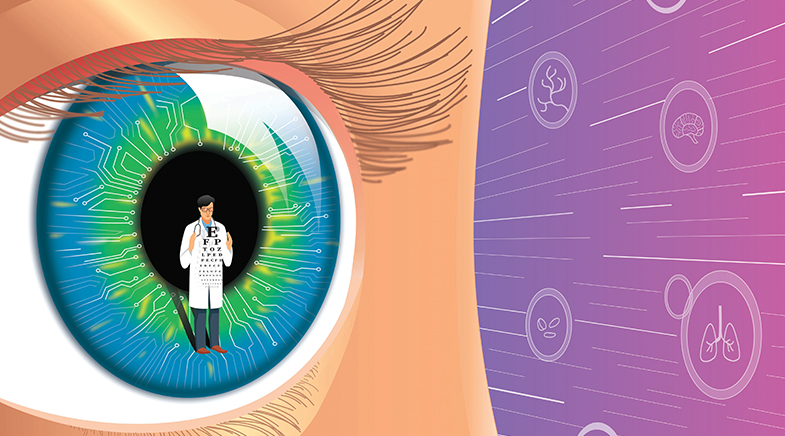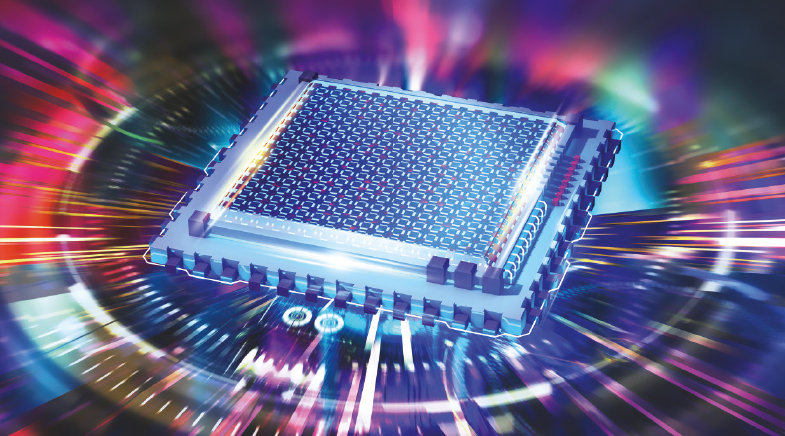Sungazer Aditya-L1 set for takeoff
-
- from Shaastra :: vol 02 issue 04 :: Jul - Aug 2023

India's first solar mission will help sharpen scientists' understanding of the Sun's characteristics, which influence the climate on Earth.
The key event in the history of Aditya-L1 happened early in 2013. This solar mission, India's first, was conceived in 2006 as a small satellite with one instrument orbiting Earth at about 800 km. U.R. Rao, former Chairman of the Indian Space Research Organisation (ISRO), mooted a plan to broaden the objectives of the mission. To him, a low-Earth orbiter was not ambitious enough. Why not send a full observatory orbiting the Sun itself?
ISRO had already gone through one such expansion of an idea in the late 1990s, when a proposal to build an orbiting X-ray telescope was converted into a plan for a full-fledged observatory. Called Astrosat, the telescope (which had not yet been launched in 2013), was equipped to study the universe in multiple wavelengths. Rao, a solar physicist by training, had been encouraging the astronomy community to think big. As the Astrosat was getting ready for launch in 2015, Rao proposed a similar multiwavelength mission to the Sun.
The meeting at the ISRO headquarters in 2013 was to brainstorm about the possibilities. After the meeting, three young scientists went to a tea shop outside the ISRO headquarters to brainstorm among themselves. "We realised that the mission didn't have a full disc imager of the Sun," says Dibyendu Nandi, who heads the Center of Excellence in Space Sciences India, Kolkata. "So we sat at the tea shop and dreamt up one."
The other two scientists were Durgesh Tripathi, Professor at the Inter-University Centre for Astronomy and Astrophysics (IUCAA) in Pune, and Dipankar Banerjee, now Director of the Aryabhatta Research Institute of Observational Sciences at Nainital. The Aditya-L1 mission is set for launch in September 2023. The full disc imager that the three scientists conceived in the tea shop is now one of the most complex pieces of equipment in the satellite, with unprecedented imaging capabilities in the ultraviolet band, close to visible light.
Aditya-L1 will be placed at Lagrange point 1 (L1), about 1.5 million kilometres away from Earth towards the Sun, roughly four times the distance from the Earth to the Moon. The spacecraft has seven instruments that, together, provide an observation package that can simultaneously image the Sun in visible light, ultraviolet and X-rays. They can intercept and analyse particles that speed away from the Sun past the spacecraft. They can study the magnetic fields of the Sun, and measure energy flows from its surface layers towards the atmosphere.
Over the decade, the mission will help scientists closely watch the upper atmosphere of the Sun, understand how the corona gets heated to one million degrees while temperatures are much lower closer to the Sun, find out how magnetic field lines form and snap and cause parts of the corona to be ejected, work out how solar radiation affects the Earth's climate, and so on. "Aditya-L1 inputs will help to build precise solar atmospheric models," says R. Satheesh Thampi, senior scientist at the Space Physics Laboratory, Vikram Sarabhai Space Centre.
The Sun is only 150 million kilometres away from Earth; yet, scientists do not understand its dynamics very well. However, understanding the Sun's behaviour is critical to predicting solar storms and protecting the Earth from them. "What we understand about the Sun is minimal compared to what we don't understand," says B. Raghavendra Prasad, Principal Investigator of the Visible Emission Line Coronagraph (VELC) on the mission. Prasad retired in 2023 as Senior Professor from the Indian Institute of Astrophysics (IIAP), Bengaluru, which developed the coronagraph.
With a carefully chosen package of instruments, Aditya will let scientists observe the Sun in a way not possible so far.
CURATION WAS THE KEY
Solar missions are not very common in the astronomy community. Ever since space exploration started in the 1960s, space agencies have sent 22 missions to the Earth's star. There are technical challenges to flying close to the Sun. One side of the spacecraft heats up; there is extreme cold on the other side. The radiation becomes intense as the spacecraft moves closer to the Sun. Charged particles disturb the electronics on board. Large spacecraft require large rockets, and large rockets produce severe vibrations that the onboard instruments need to withstand during launch.
In 2013, when serious discussions started on Aditya-L1, there were two major missions active and providing valuable data to the scientific community: the Solar and Heliospheric Observatory (SOHO) from the European Space Agency, and the Solar Dynamics Observatory of the National Aeronautics and Space Administration (NASA). (There were other smaller missions; and bigger ones are being planned by both the American and European space agencies.) The Indian solar science community analysed all these missions and selected seven instruments to fly on Aditya (see table: 'The Sun in their sights'). In the process, they created capabilities that were absent in this combination in any other current or planned mission to the Sun.
Two large instruments on board Aditya – the Solar Ultraviolet Imaging Telescope (SUIT); and the VELC, which will image the solar corona – have counterparts in SOHO. However, unlike SOHO instruments, VELC has the ability to do the spectroscopic analysis of the corona as well as measure the thermodynamic properties (temperature, density and so on) of the solar plasma. The ultraviolet imager, likewise, creates images in different wavelengths of the full disc in multiple wavelengths, and thus provides information with unprecedented richness.

The VELC was conceived largely to study the corona, the outer layer of the Sun's atmosphere, which is seen well only during an eclipse and has fascinated solar scientists ever since they started to study it closely. The corona gets very hot, as high as a million degrees Celsius, while the solar surface is only at a temperature of 6,000° C. And yet the corona is a million times dimmer than the surface. What makes it so hot and yet so dim? The magnetic fields in the Sun are considered to be the culprit, but physicists do not quite know the mechanism of heating.
The corona has highly energetic particles that can escape the Sun's gravity and hurtle through space, a phenomenon called the solar wind. Sometimes, the Sun throws out so much matter – billions of tonnes – in an event called coronal mass ejection; it can affect daily life on Earth. "Can we develop tools to predict coronal mass ejections? For this, data has to be collected from close to the Sun," says Prasad.

The study of solar storms and coronal mass ejections assumed additional significance when the space age started. Scientists found out that space weather can affect satellites, often with serious consequences. In February 2022, Elon Musk's SpaceX lost over 40 satellites barely a day after launch due to a geomagnetic storm – rapid variations in the Earth's magnetic field – that was caused by ejections from the Sun. The dependence of human civilisation on communication technology has inspired efforts to understand the Sun better, and specifically the mechanism behind heating and ejections of the corona.
The Sun's main disc is so bright that the corona is visible from Earth only during a total solar eclipse. "Whenever there is a solar eclipse," says Banerjee, "you can find an astronomer going to that part of the globe to do observations just for a few minutes." Banerjee himself has been part of several such expeditions.

For Aditya to image the corona, scientists had to first find a way to block out the light from the main solar disc, just the way it is blocked during an eclipse. The coronagraph creates a continuous and artificial eclipse by blocking light from the main disc. It can then image the entire 5 million km of the corona, right from the innermost to the outermost layer. "Our instrument can study the corona layer in a way that no other mission has achieved," claims Prasad. It required the development of mirrors that are exceptionally smooth. In fact, their surface roughness is expressed in angstroms, or one-billionth of a metre. "LIGO has achieved this roughness after a decade and a half of effort," says Prasad. (The Laser Interferometer Gravitational-Wave Observatory, or LIGO, is based in the U.S. and is used to detect gravitational waves.)
LIGO mirrors are flat. The mirrors in the VELC are curved and are, therefore, more challenging. ISRO developed the mirrors in-house. The mechanical tolerance of the machine was no more than 25 microns; a micron is one-millionth of a metre. The entire structure had to be machined down over three years from a mass of 800 kg to 40 kg. The VELC was handed over to ISRO at the end of January 2023.
ULTRAVIOLET IMAGER
ISRO put out a call for making Aditya payloads in April 2013. After the discussion in the tea shop, Durgesh Tripathi went back to IUCAA and talked to his colleague A.N. Ramaprakash, an astronomer and instrument builder. The two IUCAA scientists and other collaborators applied to ISRO for developing an ultraviolet imager. After several reviews, the project was approved in 2015. Scientists started building SUIT in 2016.
The scientific goal of SUIT, in a broad sense, was to understand how the Sun radiates energy. It will help scientists understand how the solar atmosphere works; how the upper layer gets heated; how the different layers of the atmosphere are connected through magnetic fields; and what role the magnetic field plays in heating. Scientists designed SUIT to focus on wavelengths that haven't been studied well. These wavelengths, from 200 to 400 nanometres, were critical to understand the solar atmosphere but haven't been studied well. They also play an important role in driving the climate on Earth. "We need to build on what has been studied as well as fill the gaps," says Ramaprakash.
The instrument had to be designed for a wide variety of radiation intensities. All light and heat outside the waveband of interest had to be filtered out. Even within the 200-400 nm band, there was a big variation in the amount of radiation entering the detectors. When some areas of the Sun become active, there is another jump in the radiation intensity. The detectors have to ensure that the faintest light gets recorded and also that the brightest does not saturate the detectors. "It is difficult to design telescopes that can deal with the variation of brightness," says Janmejoy Sarkar, who worked on the SUIT project. Solar flares are well-observed phenomena, but the physics of the flare is not well understood. They have been observed in X-rays most of the time, but 70% of the flare energy is contained in visible light and ultraviolet. Apart from SUIT, Aditya also contains soft and hard X-ray detectors; together they cover all the wavelengths. Since X-rays are usually emitted before ultraviolet during a flare, the X-ray detectors may pick up the signature of a flare before the ultraviolet radiation reaches the spacecraft. SUIT will then locate the activity and take rapid images. "Studying the dynamics of the Sun efficiently is SUIT's aim," says Ramaprakash. The idea is to understand why the flare happens, and what the activities that lead up to a flare are.
It is hard to make the optics to image in ultraviolet radiation. It needs exceptionally clean rooms, of the kind IUCAA had to create for the programme. The Laboratory for Electro-Optics Systems (LEOS) of ISRO had to push the envelope for Astrosat. For Aditya, it had to push it again. "Making such mirrors requires super-polishing technology, which will have several spin-offs in multiple domains, especially for making high-energy laser beams in defence systems," says Venkata Suresh Narra, Project Associate at IIAP.
The other instruments also complement the VELC and SUIT. The Aditya Wind Solar EXperiment (ASPEX) measures the solar wind speed and other properties at the Lagrange point L1, where the spacecraft is positioned, including the precise direction. Digital magnetometers measure the magnetic fields at L1. "Each of our experiments has several novel scientific goals that make this mission unique," said Dibyendu Chakrabarty, Principal Investigator of ASPEX and a Professor at PRL. ASPEX will help understand the dynamics of solar wind particles like protons and helium. "The current experiments primarily focus on protons, but helium is a promising solar wind species for probing the processes that generate the solar wind and regulate its speed," Chakrabarty adds.
Aditya is India's first solar mission. Like the lunar mission Chandrayaan, the third of which was launched in July 2023, Aditya is considered to be only the first of a series of missions. "Once we reach Lagrange point 1, we feel we can have our next mission much closer to the Sun," says Seetha Somasundaram, former Programme Director of ISRO. "Perhaps at the last Lagrange point."
See also:
Have a
story idea?
Tell us.
Do you have a recent research paper or an idea for a science/technology-themed article that you'd like to tell us about?
GET IN TOUCH













